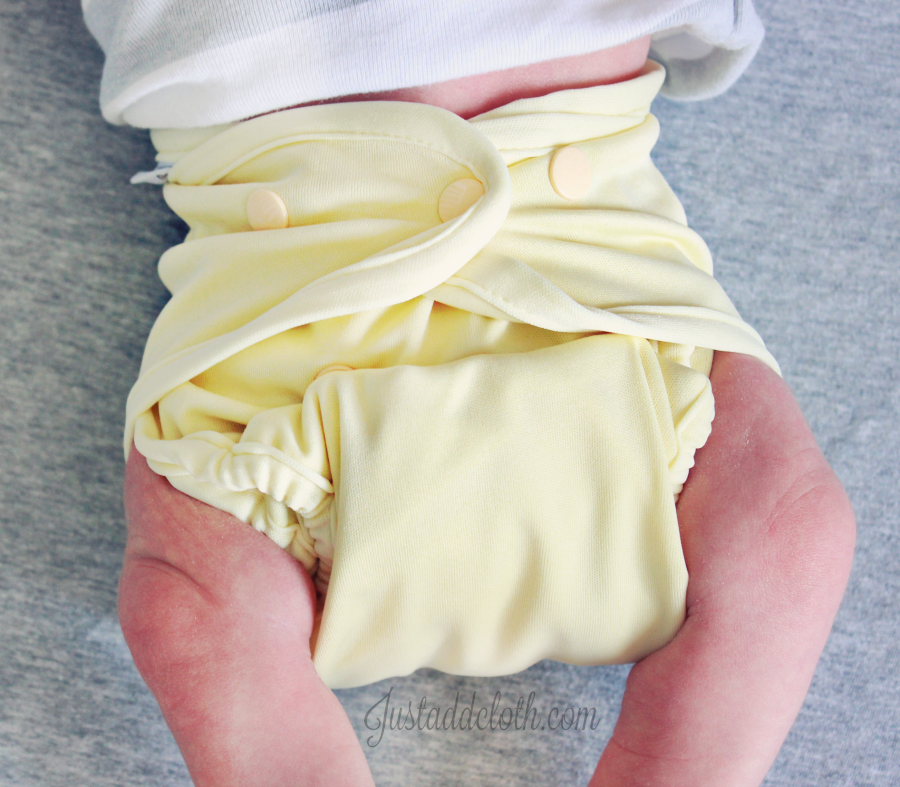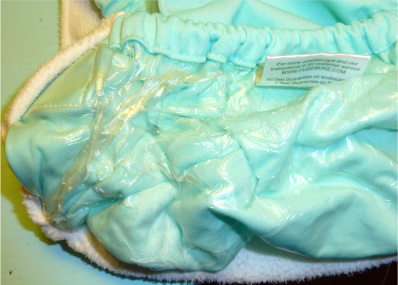
Newborn poop may be plentiful, but it is also easy to wash out of your cloth diapers. Little newborn digestive systems don’t have the bacteria, buildup, or bulk in them that adult systems contain.
Solid waste from exclusively breast fed and formula fed babies is water soluble and therefore no rinsing is necessary before placing them in the washer. Solids from babies eating purees and table foods should be knocked off into the toilet prior to laundering. Some people may prefer to use a diaper sprayer to rinse diapers over the toilet before placing them in the washer. Flushable liners are another option, but not necessary for the newborn phase. In general, the only time liners or extensive rinsing is necessary is when baby is transitioning from exclusive breastfeeding to solids. This can cause a sticky texture in the waste making it difficult to remove from the diaper. This phase generally only lasts a few weeks. Occasionally, infant formula can cause sticky poop on its own depending on the formula. In this case, you may find yourself spraying or dunking long before introducing solid foods. If your baby gets into a routine and tends to do one large bowel movement per day, it can have quite a bit of volume and you may want to spray or dunk despite it technically being water soluble. With my son, I needed to start swishing around three months even though he only received one bottle of formula a day and was breastfed the rest of the time. We only encountered one poopy diaper every two days at that time and it was so full swishing just made sense.
Your washing routine will depend on the type of washer you have.
-Pre-rinse in cold water to remove any residual solids and excessive urine and ammonia. This will remove any of those little yellow cottage cheese type pieces in your newborns diaper. I actually pre-rinse in luke warm water. I feel it dissolves the pieces more quickly. For the first year of our cloth diapering adventure, we lived in an apartment building with 20 people sharing one rickety washer. I learned first hand, that hand rinsing in a sink or bucket is very effective when you need to eliminate that first pre-rinse in the machine.
-Hot or warm wash (not on sanitize) with a normal amount of diaper friendly detergent. For regular detergents, use the amount directed or start with half and increase the amount over time if you feel the need. If you have an HE washing machine, only a tablespoon or so is needed. Technically, you might get away with less detergent for the newborn phase.
Once your baby gets older you will likely need to use more detergent and alter your wash routine. Toddler diapers are more prone to ammonia buildup than newborn diapers. Newborns consume so much liquid, their urine is generally pretty diluted. The washing routine should not need intensifying or stripping until your baby reaches about six months old and eats solids. My son didn’t care for solids until 10 months of age. I have a feeling this new baby will be into food at an earlier age.
-Warm rinse
-Followed by another rinse. Warm water works a bit better, but cold is fine for the second rinse too. For HE machines, an additional rinse may be needed. If there appear to be any suds at all remaining, your diapers need another rinse. Some people are able to trick their machines into using more water by putting a wet bath towel in with their diaper load. If your machine has the option to cancel the spin, you can also use that to trick the machine into thinking it is a heavier load.
-You may dry your diapers in the dryer on low heat. However, this will make the elastic wear out quicker and can damage the PUL layer. Line drying your covers and Pocket diaper shells is preferred. Inserts can go in the dryer on any temp or line dry. If they feel stiff after line drying, placing them in the dryer for 10 minutes can soften and fluff them up. Again, do not use dryer sheets or bars with any of your cloth diapers. If the seams of your PUL shells or covers are leaking or wicking, you can reseal them in the dryer by drying on high heat for about 20 minutes. However, there have some instances of covers being ruined if they stick to the vent and melt.
Newborn diaper laundry is the easy part! The water soluble breast milk poop is like a cloth diapering honeymoon phase compared to toddler poop. While you can of course wash your newborn and toddler diapers together, I am choosing to do them in separate loads. My newborn wash routine is easier than the one I use for my toddlers diapers. Plus, it is easier to match up inserts if I keep them separate. If I used all flats for both, it wouldn’t matter as much. With two in diapers, unless I washed every single day, the diaper laundry would likely need to be split up into two loads anyway.






Pingback: Cloth Diapering: Learn from Experience - Handmade with Ashley